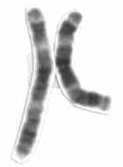3q29 microdeletion syndrome
A genetic disorder caused by a deletion on chromosome 3
| 3q29 microdeletion syndrome | |
|---|---|

| |
| Synonyms | |
| Pronounce | |
| Specialty | Medical genetics |
| Symptoms | Developmental delay, intellectual disability, autism spectrum disorder, anxiety, schizophrenia |
| Complications | N/A |
| Onset | Congenital |
| Duration | Lifelong |
| Types | |
| Causes | Genetic mutation |
| Risks | |
| Diagnosis | Genetic testing, chromosomal microarray analysis |
| Differential diagnosis | |
| Prevention | |
| Treatment | Supportive care, special education, behavioral therapy |
| Medication | |
| Prognosis | Variable |
| Frequency | 1 in 30,000 to 1 in 40,000 |
| Deaths | |
3q29 microdeletion syndrome is a rare genetic disorder characterized by a deletion of a small segment of chromosome 3 at the q29 band. This condition can lead to a variety of developmental and health issues, including intellectual disability, developmental delay, and distinctive facial features.
Genetics[edit | edit source]
The 3q29 microdeletion syndrome is caused by the deletion of a segment of DNA on the long arm (q arm) of chromosome 3. This deletion typically spans approximately 1.6 million base pairs and affects multiple genes. The deletion is usually de novo, meaning it occurs as a new mutation in the affected individual and is not inherited from the parents.
Clinical Features[edit | edit source]
Individuals with 3q29 microdeletion syndrome may present with a range of clinical features, which can vary in severity. Common features include:
- Intellectual disability
- Developmental delay
- Autism spectrum disorder
- Microcephaly (small head size)
- Distinctive facial features such as a long face, high nasal bridge, and prominent ears
- Congenital heart defects
- Gastrointestinal issues
Diagnosis[edit | edit source]
Diagnosis of 3q29 microdeletion syndrome is typically made using chromosomal microarray analysis, which can detect the deletion of the 3q29 region. Karyotyping may also be used, but it is less sensitive for detecting small deletions.
Management[edit | edit source]
There is no cure for 3q29 microdeletion syndrome, and management focuses on addressing the specific symptoms and needs of the individual. This may include:
- Early intervention programs for developmental delays
- Special education services
- Behavioral therapy for autism spectrum disorder
- Regular monitoring and treatment of associated health issues
Prognosis[edit | edit source]
The prognosis for individuals with 3q29 microdeletion syndrome varies depending on the severity of symptoms and the presence of associated health conditions. With appropriate support and interventions, many individuals can lead fulfilling lives.
Related pages[edit | edit source]
Search WikiMD
Ad.Tired of being Overweight? Try W8MD's physician weight loss program.
Semaglutide (Ozempic / Wegovy and Tirzepatide (Mounjaro / Zepbound) available.
Advertise on WikiMD
|
WikiMD's Wellness Encyclopedia |
| Let Food Be Thy Medicine Medicine Thy Food - Hippocrates |
Translate this page: - East Asian
中文,
日本,
한국어,
South Asian
हिन्दी,
தமிழ்,
తెలుగు,
Urdu,
ಕನ್ನಡ,
Southeast Asian
Indonesian,
Vietnamese,
Thai,
မြန်မာဘာသာ,
বাংলা
European
español,
Deutsch,
français,
Greek,
português do Brasil,
polski,
română,
русский,
Nederlands,
norsk,
svenska,
suomi,
Italian
Middle Eastern & African
عربى,
Turkish,
Persian,
Hebrew,
Afrikaans,
isiZulu,
Kiswahili,
Other
Bulgarian,
Hungarian,
Czech,
Swedish,
മലയാളം,
मराठी,
ਪੰਜਾਬੀ,
ગુજરાતી,
Portuguese,
Ukrainian
Medical Disclaimer: WikiMD is not a substitute for professional medical advice. The information on WikiMD is provided as an information resource only, may be incorrect, outdated or misleading, and is not to be used or relied on for any diagnostic or treatment purposes. Please consult your health care provider before making any healthcare decisions or for guidance about a specific medical condition. WikiMD expressly disclaims responsibility, and shall have no liability, for any damages, loss, injury, or liability whatsoever suffered as a result of your reliance on the information contained in this site. By visiting this site you agree to the foregoing terms and conditions, which may from time to time be changed or supplemented by WikiMD. If you do not agree to the foregoing terms and conditions, you should not enter or use this site. See full disclaimer.
Credits:Most images are courtesy of Wikimedia commons, and templates, categories Wikipedia, licensed under CC BY SA or similar.
Contributors: Prab R. Tumpati, MD
